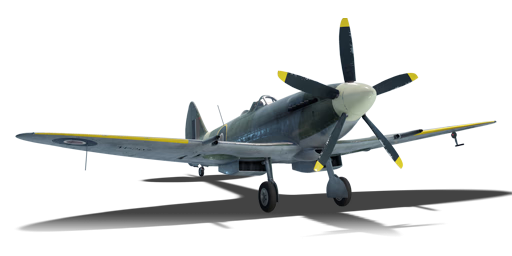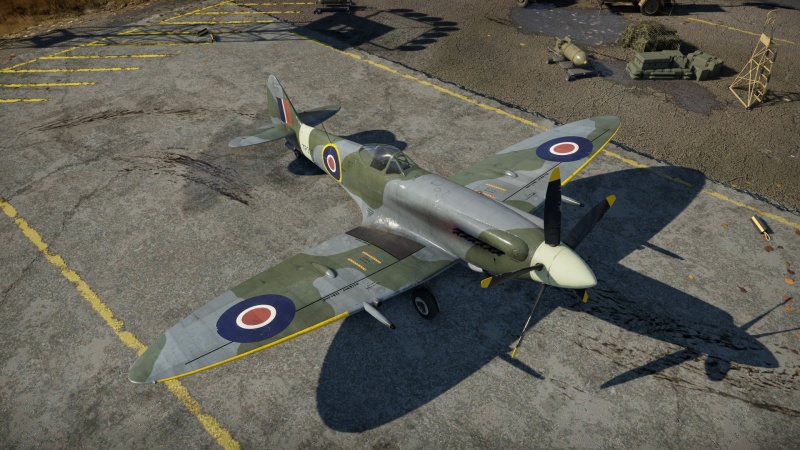Spitfire F Mk XVIIIe
| This page is about the British fighter Spitfire F Mk XVIIIe. For other versions, see Spitfire (Family). |
Contents
Description
Although visually similar to the Mk XIV, the Spitfire Mk XVIIIe was purpose-built from scratch as a new project, unlike the Mk XIV which was a Spitfire Mk VIII fuselage with a Griffon engine. The Mk XVIIIe received strengthened fuselage, gear, and airframe due to the added weight of the additional wing and fuselage fuel tanks. 299 of the Mk XVIIIe were made, the first 99 being in fighter configuration, with the remaining 200 for photo reconnaissance. The Mk XVIIIe was equipped with a type "E" wing, featuring two 20 mm Hispano cannons and two 12.7 mm Browning M2 machine guns. The Mk XVIIIe came too late to take part in WWII. Instead, between 1948 and 1949, they engaged in fighting Egyptian and Israeli Spitfires with 32nd and 208th Squadron RAF in Palestine.
The Spitfire F Mk XVIIIe was introduced in Update 1.41. Featuring much greater engine power due to its Griffon engine, the Mk XVIIIe is faster than the previous Merlin-powered variants, at cost of decreased manoeuvrability. However the Spitfire is still able to out-turn most of its opponents, while retaining the great climb rate and speed as well as superior armament.
General info
Flight performance
| Characteristics | Max Speed (km/h at 7,927 m) |
Max altitude (metres) |
Turn time (seconds) |
Rate of climb (metres/second) |
Take-off run (metres) | |||
|---|---|---|---|---|---|---|---|---|
| AB | RB | AB | RB | AB | RB | |||
| Stock | 687 | 664 | 12000 | 19.2 | 19.9 | 17.9 | 17.9 | 420 |
| Upgraded | 765 | 718 | 17.4 | 18.1 | 35.8 | 23.3 | ||
Details
| Features | ||||
|---|---|---|---|---|
| Combat flaps | Take-off flaps | Landing flaps | Air brakes | Arrestor gear |
| X | X | ✓ | X | X |
| Limits | ||||||
|---|---|---|---|---|---|---|
| Wings (km/h) | Gear (km/h) | Flaps (km/h) | Max Static G | |||
| Combat | Take-off | Landing | + | - | ||
| 798 | 260 | N/A | N/A | 260 | ~10 | ~6 |
| Optimal velocities (km/h) | |||
|---|---|---|---|
| Ailerons | Rudder | Elevators | Radiator |
| < 321 | < 400 | < 350 | > 500 |
| Compressor (RB/SB) | ||
|---|---|---|
| Setting 1 | ||
| Optimal altitude | 100% Engine power | WEP Engine power |
| 4,600 m | 1,510 hp | 2,129 hp |
| Setting 2 | ||
| Optimal altitude | 100% Engine power | WEP Engine power |
| 8,600 m | 1,320 hp | 1,824 hp |
Survivability and armour
- 6 mm Steel plate in front of engine above the propeller.
- 12.7 mm Steel plate between fuel tanks.
- 38 mm Bulletproof glass in front of the pilot.
- 4 mm Steel plates behind the pilot, coupled with another 4-7 mm Steel plate behind that.
- 3 mm Steel plates around ammunition.
- Critical components located at the front of aircraft (fuel, pilot, engine, controls)
- More fuel tanks located in wings leading edge
Modifications and economy
Armaments
Offensive armament
The Spitfire F Mk XVIIIe is armed with:
- 2 x 20 mm Hispano Mk.II cannons, wing-mounted (135 rpg = 270 total)
- 2 x 12.7 mm M2 Browning machine guns, wing-mounted (260 rpg = 520 total)
Suspended armament
The Spitfire F Mk XVIIIe can be outfitted with the following ordnance:
- Without load
- 2 x 250 lb G.P. Mk.IV bombs (500 lb total)
- 3 x 250 lb G.P. Mk.IV bombs (750 lb total)
- 1 x 500 lb G.P. Mk.IV bomb (500 lb total)
- 1 x 500 lb G.P. Mk.IV bomb + 2 x 250 lb G.P. Mk.IV bombs (1,000 lb total)
- 8 x RP-3 rockets
Usage in battles
The Spitfire F Mk XVIIIe is nearly identical in playstyle to its predecessor, the Spitfire Mk XIVe. The only major difference between the two vehicles is the latter's ability to carry a larger and more diverse selection of suspended armament. Primarily, the Spitfire is the pinnacle of dogfighting at mid to high altitude. This fighter excels at catching unsuspecting pilots still climbing to altitude and excels in a turning and energy fighting playstyle.
With a powerful Griffon engine, this plane has amazing acceleration and climb rate--even better than that of the Merlin Spitfires. Although less manoeuvrable than they are, this Spitfire is still very capable in turnfights. Indeed, its mix of turning ability and engine performance is one of this vehicle's greatest strengths.
This aircraft has an ideal operating altitude of between 4,000 m and 6,000 m due to the properties of the Griffon engine, but this aircraft has no problems climbing past that altitude. However, manoeuvrability is slightly compromised at altitudes higher than 7,000 m. This aircraft excels at energy dogfighting, a mix between energy fighting and dogfighting. The insanely good acceleration coupled with the great climb rate and energy retention allows this aircraft to excel in horizontal dogfighting as well as vertical energy manoeuvres. Don't get into extended energy fights as many pure energy fighters can outdo this aircraft in pure energy fights.
American aircraft can outdo this plane in speed and energy retention, but cannot dogfight this plane very well. German planes are even more dangerous due to their high top speed and energy retention. This plane can adequately fight Japanese aircraft, but Zeroes can turn faster than the Spitfire, though they don't accelerate in a straight line as quickly. If you stay up above 4,000 m, you can deal effectively with most Soviet aircraft, which perform best lower down.
Boom and zoom attacks and pure energy fights are this plane's weakness; it does not hold up well in drawn-out fights of speed.
This plane is armed with both 20 mm cannons and 12.7 mm machine guns. They don't carry an extremely large ammunition pool but don't have too little either. A little bit of spray is fine, but it would still be wise to keep an eye on ammo count. In order to preserve cannon ammo, it is possible to fire the machine guns independently; this can be helpful in gauging the lead required to fire at enemies far away.
Additionally, this vehicle can mount up to 1,000 lbs of bombs or 8 RP-3 rockets. These can be used in Air Realistic Battles to destroy pillboxes and tanks. Even better, they are deadly in Ground Realistic battles, where they can destroy even heavily-armoured tanks. The quantity of suspended armament available to this aircraft and its very good dogfighting capabilities make this plane very effective in mixed battles: after dropping ordnance to destroy ground targets, the pilot can then shift to an air-superiority role, protecting friendly ground units from enemy attackers and fighters.
Manual Engine Control
| MEC elements | ||||||
|---|---|---|---|---|---|---|
| Mixer | Pitch | Radiator | Supercharger | Turbocharger | ||
| Oil | Water | Type | ||||
| Not controllable | Controllable Auto control available |
Not controllable Not auto controlled |
Controllable Auto control available |
Combined | Controllable 2 gears |
Not controllable |
Pros and cons
Pros:
- Great rate of climb
- Excellent turning ability and good roll rate
- Good zoom climber
- Fast acceleration
- Cools well at 100% throttle
- Dive speed and handling is very good
- Able to mount bombs or rockets
Cons:
- Engine and cooling systems are easily damaged
- Requires slow landing speeds
- Unimpressive ammunition count
History
| Archive of the in-game description | |
|---|---|
|
The Supermarine Spitfire Mk.XVIII was a single engine single, seat fighter which served with the Royal Air Force during the early post war period. After the initial teething problems encountered with the introduction of the Rolls Royce Griffon engine to the Spitfire line, the Spitfire Mk.XIV had been used successfully in large numbers in the European Theatre of Operations. The Mk.XIV had seen notable modifications and transitions throughout its wartime service; the Spitfire Mk.XVIII built on this experience. The Spitfire Mk.XVIII was also equipped with a Rolls Royce Griffon 65 engine with two stage supercharger rated at 2050 hp, high visibility teardrop canopy and a Type E Wing with two Hispano 20 mm cannon and two .50 cal Browning machine guns or four 20 mm cannons and externally was very similar to the later production Mk.XIV Spitfires. However, the Spitfire Mk.XVIII also featured a strengthened fuselage and an additional 31-gallon fuel tank in the rear fuselage. The Spitfire Mk.XVIII entered service with No.60 Squadron at Singapore in January 1947. The Mk.XVIII was used offensively against insurgents during the Malayan uprising. The Mk.XVIII was also involved in air-to-air combat during the 1948 Arab-Israeli War where in one famous incident, two Israeli Spitfire Mk.IXs flown by a Canadian and an American pilot shot down four RAF Spitfire Mk.XVIIIs of No.208 Squadron. Some 300 Spitfire Mk.XVIIIs were built with only the Royal Indian Air Force purchasing 20 as an export customer. | |
Media
- Skins
- Videos
See also
Links to the articles on the War Thunder Wiki that you think will be useful for the reader, for example:
- reference to the series of the aircraft;
- links to approximate analogues of other nations and research trees.
External links
| Supermarine | |
|---|---|
| Spitfires | |
| Merlin engine | Spitfire Mk Ia · Spitfire Mk IIa · Spitfire Mk.IIa Venture I · Spitfire Mk IIb |
| Spitfire Mk Vb · Spitfire Mk Vb/trop · Spitfire Mk Vc · Spitfire Mk Vc/trop | |
| Spitfire F Mk IX · Spitfire F Mk IXc · Spitfire F Mk XVI | |
| Spitfire LF Mk IX · Plagis' Spitfire LF Mk IXc | |
| Griffon engine | Spitfire F Mk XIVc · Spitfire F Mk XIVe · Prendergast's Spitfire FR Mk XIVe · Spitfire F Mk XVIIIe · Spitfire F Mk 22 · Spitfire F Mk 24 |
| Export | ▄Spitfire Mk Vb/trop · ▃Spitfire LF Mk IXc · ▂Spitfire Mk IXc · Spitfire Mk IXc · Spitfire Mk.IX (CW) · Weizman's Spitfire LF Mk.IXe · ▄Spitfire FR Mk XIVe |
| Seafires | Seafire LF Mk.III · Seafire F Mk XVII · Seafire FR 47 |
| Export | ▄Seafire LF Mk.III |
| Jet fighters | Attacker FB 1 · Attacker FB.2 · Scimitar F Mk.1 · Swift F.1 · Swift F.7 |
| Hydroplanes | Walrus Mk.I |





